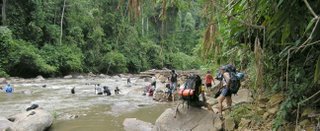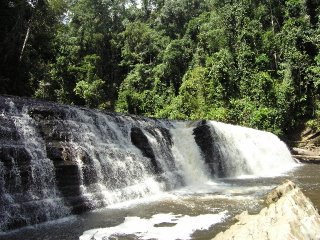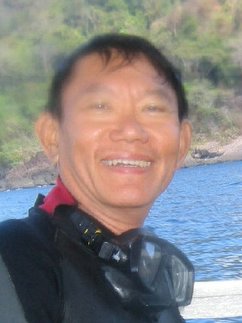Imbak Canyon Expedition, Sabah, 12 - 20 Nov 05



This 9-day/8-night expedition was organised by the Malaysian Nature Society, Photography Special Interest Group. Thirteen members took part.
Imbak Canyon, 10km long & 3km. wide with a flattish bottom at about 150 metres above sea level, is sited in the district of Tongod in the heart of Sabah. It lies about 15km. north of the Maliau Basin Conservation Area and to the west of Danum Valley Conservation area.
It is hemmed on three sides by sandstone ridges, reaching 1,120 metres at their highest peak. The region is a complete rainforest ecosystem by itself and is approximately 300 sq.km. It is one of the last remaining pristine lowland rainforest in Sabah, probably the largest contiguous lowland dipterocarp forest left in Sabah. Imposing waterfalls can be found along the sides and at the mouth of the Canyon.
Presently it is not accorded formal protection status, so logging is going on. The Sabah Foundation (Yayasan Sabah) was allocated a forest concession area to manage it on a sustainable yield basis. Recognising its high biodiversity value, Yayasan Sabah voluntarily designated this area as a conservation area in 2003.
Raleigh International volunteers had visited Imbak Canyon in 2004 & 2005. They constructed quarters for Wildlife Department rangers and established trails into the canyon for researchers and upgraded tracks to a waterfall and jungle camp.
(For details see: http://www.ysnet.org.my/conservation_area.htm,
http://www.raleighinternational.org/overseas/malaysia.html
http://allmalaysia.info/news/story.asp?file=/2005/4/26/state/10754756&sec=mi_sabah
http://www.dailyexpress.com.my/news.cfm?NewsID=26152)
Day 1 Sat 12 Nov.
Our team of 13 members arrived at Sandakan Airport at 10am. We were picked up by Jimmy Omar, the camp manager, in four 4WD vehicles (one Landcruiser & three HiLux crew-cab Toyotas). Our convoy headed for our base camp via Jln. Labuk - Batu 32 - Jln. Telupid - Simpang Empat (a distance of 114km), passing through oil palm plantations, logging concessions and then to the last village, Kg. Milian which we reached at 4.00pm. Unfortunately, we could not cross the swollen Imbak River due to heavy rain on the previous 3 days. Even though we were less than 20km from our base camp there was no other option but to return to Sandakan. We stayed the night at the Yayasan Sabah headquarters which had guest rooms.
Day 2 Sun 13 Nov.
At 5.15am the convoy of 4-wheel drive vehicles set out for Tawau for the alternative route to the Imbak base camp, bypassing the Imbak River. We reached Tawau at about 11am. An amusing incident happened when we stopped to refuel. One of the drivers filled petrol to his diesel-engine HiLux and had to drain off the petrol. Poor fellow must be tired from the long hours of driving.
Our journey took us from paved to laterite to logging roads. At one point along the logging roads we were caught in a traffic jam caused by a huge truck-trailer, fully laden with logs, which had skidded and lain across the track. There were about a hundred trucks all fully laden with logs (imagined how many trees had been destroyed) waiting for the fallen truck to be pulled upright. Fortunately, we did not have to wait too long and about half an hour later we could pass.
At 5.45pm when we were only about 3km. from reaching base camp our path was blocked by a huge fallen tree. One of the drivers had to walk to base camp to get help from the rangers. It was 7pm. and dark before 7 rangers returned with a chainsaw. They only took about 10 mins. to saw through and we helped them to clear the debris. The last two kms. stretch was very muddy with deep pot-holes, it was tough going before we could finally set foot on the camp. The journey from Tawau to the Imbak base camp took more than 12 hrs.
The base camp comprised of 3 timber long-houses interconnected by a boardwalk, all the structures were supported by stilts. One of the long-houses was the Forest Rangers' quarters, another was for visitors and the last one housed the dining area and kitchen. We slept on canvas hammocks stretched across beds made with logs. We hung up mosquito nets. The beds were quite comfortable except for one of our members who was well over 6 feet tall. Water was collected from the roof by gutters which flowed to a storage tank. We did our washings in the river nearby. Toilets were pit latrines. Electricity was supplied by a generator and power was available from 7pm to 10.30pm.
Day 3 Mon 14 Nov.
We had lost one day due to the detour and had to revise our itinerary. We decided to spend 3 days/2 nights trekking on the Northern Ridge to Bkt. Beruang. Due to the unavailability of water supply during the first day of the trek each of us had to carry at least 3 litres of water. It was estimated by the rangers that our group would take about 8 hrs. of trekking before we could set up camp for the night. Three of the younger members of our group decided to stay back at base camp. We left base camp at about 10am. after breakfast and packed ready our lunch & dinner.
A short distance away we came across our first obstacle, crossing a river with strong current. Boulders and stones seemed to be everywhere. The rangers went across first and formed a line to pass our backpacks and equipment over to the other side. Then we were assisted in our crossing by the rangers. There were several anxious moments for the shorter participants as the water level reached their waists. Most of the ladies opted to remove their pants, not a time for modesty. One of them asked me why I did not do so and blushing I said that I was not wearing any underwear. My bermuda shorts dried faster this way and no chafing of the groin with wet underwear.
Then we climbed slowly up a steep ridge. Along the way one of our team members stumbled and fell and could not continue. He was assisted by his wife and a ranger to return to base camp. Crossing the river again was a big problem which they solved by having our injured friend lying on his back and the ranger towing him across. Once across the ranger went to get help and returned with another ranger. Together they were able to return safely. Our friend was taken to the hospital the next day and the injury turn out to be serious which necessitated that the couple had to return to Kuala Lumpur. (After all of us returned to K.L. on successful completion of our adventure we found out that our friend suffered a broken fibula and his leg would be in a cast for 6 weeks).
The rest of the trekking was without any further mishaps. We were awed by the giant trees in the pristine forest and the numerous species of plants. As it turned out, the rangers under-estimated our fitness because our team (av. age about 50 yrs.) took less than 5 hrs. and at about 3pm. we set up our camp for the night. We ate cold dinner which we had packed earlier because no cooking could be done due to the unavailability of water. By 6pm. the forest was already dark. It was very windy and cold during the night. I could hear the wind rustling the leaves throughout the night.
Day 4 Tues 15 Nov.
We continued the trek on the Northern Ridge to Bkt. Beruang. It only took us about 3 hrs. to reach the summit.
After setting up our camp-beds (each participant had a hammock stretched between trees with a flysheet to protect from the rain) we enjoyed ourselves by taking photographs and viewing the glorious sunset from the summit. While we admired the magnificent landscape the rangers went to collect water for our lunch and dinner needs. Dinner was quickly prepared with salted mackerel and black beans, sambal and cucumbers, using mess-tins and a small gas burner. The simple food was barely sufficient to avert hunger. Then we had to face another cold and windy night.
Day 5 Wed 16 Nov.
Woke up early at 5.30am and walked up the hill to view the glorious sunrise and the clouds below us. In spite of the cold the sight of the spectacular rising sun had us happily & busily clicking our cameras. It was nearly 7am., when the sky had lost its golden lustre that we trudged back down. After a simple breakfast of bread and cold sardines we trekked back to base camp. Spent the rest of the day bathing in the Imbak River and washing our clothes.
Day 6 Thur 17 Nov.
Trekked three hours to Kangkawat Camp which was just next to the Imbak Waterfalls. This is the widest waterfall I've seen. Enjoyed ourselves with refreshing dips and hungrily ate our packed lunches. It rained in the evening, cooking under a flysheet dinner was a wet affair. One of our lady members had a fright, thought she saw a python on the tree to which her hammock was tied. The rangers had to shift her hammock to another site, nothing else would persuade her to admit that the snake was all in her imagination.
Day 7 Fri 18 Nov.
The next morning we headed back to base camp. It was a leisurely trek, the more enthusiastic shutterbugs stopping every now and then to capture the captivating flora abounding along the trail. In the evening we went for a night-trek to look for flying foxes. They moved out in the hundreds from the top of their tree roosts at about 6pm. They did not disappoint us and put on an unforgettable show.
Day 8 Sat 19 Nov.
After breakfast at 7am. it was time to leave base camp to Kampung Milian, about 26km. away. We encountered the crew-cab, which had started out earlier to collect diesel for the generator, bogged down in the muddy track. Our Landcruiser went to the rescue, 15 mins. later it too ended in the same way. Then it was the turn of another HiLux to get stuck. Fortunately one of the crew-cabs did manage to pass the muddy obstacle to get help from the nearest logging camp. It was more than an hour before a huge lumber tractor appeared. One tug from the winch was all it took to free the Lancruiser and the HiLux.
We experienced village life by staying in a ranger's house in Kg. Milian. Though having very basic amenities the ranger & his wife showed their hospitality in a gracious way.
Day 9 Sun 20 Nov.
At 7am. we left Kg. Milian for Sandakan. Finally after 7 days, a proper & hearty sea-food lunch at Bkt. Bendera.
On the way to the airport we stopped at Sepilok to visit our cousins the orang-utans. Arrived at the airport at about 3pm and reached KLIA at 8.15pm.
Though tired I felt relieved that I came home safely from a special experience.
More photos of the expedition can be seen at:
http://asia.pg.photos.yahoo.com/ph/yeohcweng/album?.dir=df65&.src=ph&store=&prodid=&.done=http%3a//asia.pg.photos.yahoo.com/ph/yeohcweng/my_photos


<< Home